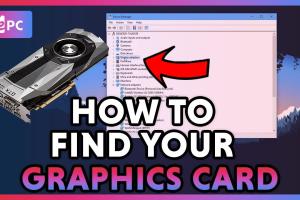Discover Your Graphics Card: 4 Simple Methods to Identify Your GPU

-
Quick Links:
- Introduction
- Method 1: Using Windows Device Manager
- Method 2: Running DirectX Diagnostic Tool (DxDiag)
- Method 3: Using Third-Party Software
- Method 4: Checking the Graphics Card Physically
- Case Studies and Examples
- Expert Insights
- Conclusion
- FAQs
Introduction
In the world of computer hardware, knowing your graphics processing unit (GPU) is crucial. Whether you're a gamer looking to optimize performance, a designer needing specific capabilities, or simply a tech enthusiast, knowing what graphics card you have can help you make informed decisions about upgrades and compatibility. In this comprehensive guide, we will explore four simple methods to identify your graphics card.
Method 1: Using Windows Device Manager
The Device Manager is a built-in Windows tool that provides a detailed overview of your system's hardware components, including your graphics card. Here’s how to use it:
- Right-click on the Start menu and select Device Manager.
- In the Device Manager window, expand the Display adapters section.
- Your graphics card will be listed there. Double-click on it to see more details.
This method is straightforward and requires no additional software installations. However, it may not provide detailed specifications.
Method 2: Running DirectX Diagnostic Tool (DxDiag)
DirectX Diagnostic Tool is another built-in utility that provides detailed information about your system's graphics card and other hardware. Follow these steps:
- Press Windows + R to open the Run dialog.
- Type dxdiag and press Enter.
- In the DxDiag window, go to the Display tab.
- Here, you will find the name and manufacturer of your graphics card, along with other details.
This method is more informative than Device Manager and can also help you troubleshoot graphics-related issues.
Method 3: Using Third-Party Software
For those who want even more detailed information about their graphics card, third-party software can be a great resource. Some popular tools include:
- GPU-Z: This specialized tool provides detailed specifications and real-time monitoring of your graphics card.
- Speccy: A general system information tool that also provides graphics card details.
- HWMonitor: This tool monitors various hardware components, including the GPU's temperature and performance metrics.
To use these tools, simply download the software from their official websites, install it, and launch it to see your graphics card information.
Method 4: Checking the Graphics Card Physically
If you're comfortable opening your computer case, you can physically check your graphics card. Here’s how:
- Turn off your computer and unplug it.
- Open the computer case (refer to your manufacturer’s instructions).
- Locate the graphics card, usually situated in a PCIe slot on the motherboard.
- Look for the manufacturer's label on the card, which will indicate the model number.
This method is the most direct way to identify your graphics card but requires caution and some technical know-how.
Case Studies and Examples
To illustrate the importance of identifying your graphics card, let's discuss a few case studies:
- Case Study 1: A gamer wanted to upgrade their graphics card to play the latest AAA titles. By using the Device Manager, they quickly identified that their current GPU was outdated, leading them to make an informed purchase.
- Case Study 2: A graphic designer experienced issues with rendering graphics. After running DxDiag, they discovered that their GPU drivers were outdated. Updating the drivers resolved their issues.
Expert Insights
According to industry experts, understanding your graphics card is crucial for optimizing performance and ensuring compatibility with software and games. In interviews with hardware specialists, they emphasized the importance of regular updates to drivers and monitoring GPU performance to maintain system efficiency.
Conclusion
Identifying your graphics card doesn't have to be a daunting task. With the methods outlined in this guide, you can quickly determine what GPU powers your system. Whether you prefer built-in tools like Device Manager and DxDiag or third-party software, knowing your graphics card is essential for making informed decisions about upgrades and performance optimization.
FAQs
1. Why is it important to know my graphics card?
Knowing your graphics card is crucial for gaming performance, software compatibility, and hardware upgrades.
2. Can I find out my graphics card without opening my computer?
Yes! You can use methods like Device Manager or DirectX Diagnostic Tool.
3. What if I can't find my graphics card using these methods?
Consider using third-party software for more detailed insights or check the manufacturer's website for support.
4. Is it safe to open my computer to check the graphics card?
Yes, but make sure to follow safety precautions such as grounding yourself and handling components carefully.
5. How often should I check for graphics card updates?
It’s recommended to check for driver updates monthly or whenever you encounter performance issues.
6. What should I do if my graphics card is not recognized?
Ensure it is correctly seated in its slot, check power connections, and update drivers or BIOS if necessary.
7. Can I use multiple graphics cards in one computer?
Yes, this is known as multi-GPU configuration, but compatibility depends on your motherboard and software.
8. Does the graphics card affect gaming performance?
Yes, the GPU is one of the most critical components affecting frame rates and graphics quality in games.
9. Are integrated graphics sufficient for gaming?
While they can handle casual gaming, dedicated graphics cards are recommended for a better experience.
10. Where can I find my graphics card’s specifications?
You can find detailed specifications using software like GPU-Z or on the manufacturer’s website.
Random Reads
- How to see all open apps and windows
- How to shoot yourself in grand theft auto 5
- How to reinstall windows xp without cd
- How to remember forgotten password
- How to create inventory list excel
- How to fix ps4 stuck in safe mode
- How to fix leaky sink trap
- How to get back to pandaria from orgrimmar
- How to get arms dealer in terraria
- Change default search engine